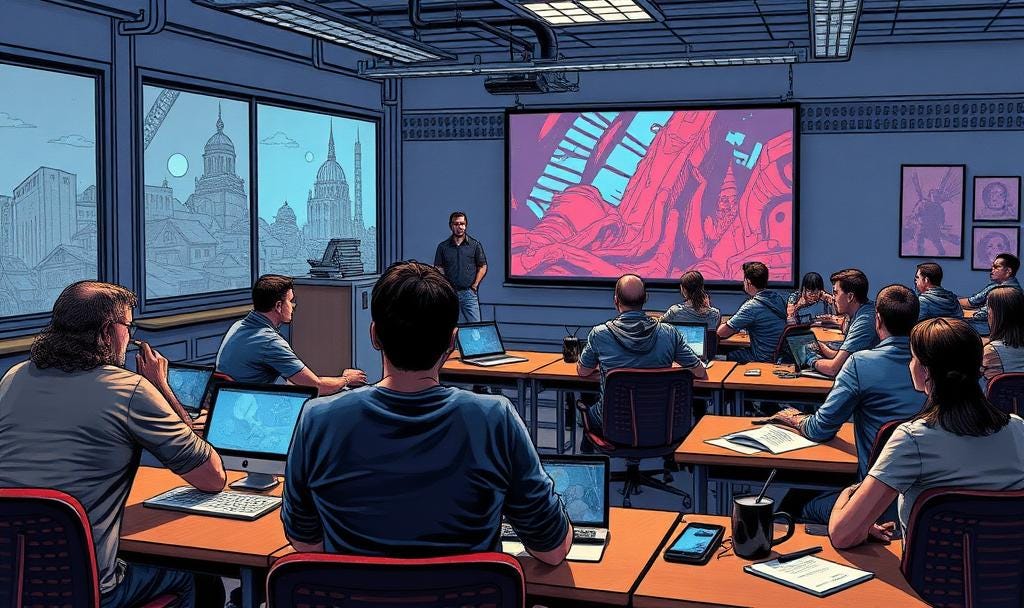Chapter 5: The Human Element
JJ tackles the crucial human aspect of AI implementation at FinTechNova. He introduces a human-in-the-loop workflow, emphasizing AI augmentation rather than replacement.
JJ arrived at the office early the next morning, Maya's concerns from the previous day still echoing in his thoughts. As he prepared for the team meeting, he realized that addressing the human element of their AI transformation was not just important—it was crucial to their success.
He began jotting down notes on the whiteboard:
Employee concerns?
Training needs?
Communication strategy?
Change management plan?
As JJ stared at these questions, he knew that their approach to these human factors would make or break their AI implementation. It wasn't just about cleaning data and implementing algorithms; it was about transforming their entire organizational culture.
The sound of the conference room door opening snapped JJ out of his contemplation. He turned to see his team filing in, and he took a deep breath. "Good morning, everyone," he began. "Today, we're going to tackle something just as important as our data infrastructure—our people infrastructure. Maya raised an excellent point yesterday, and it's time we address it head-on."
The team leaned in, sensing the shift in focus. JJ could see a mix of curiosity and apprehension on their faces. He knew that the conversation they were about to have would shape the future of FinTechNova's AI journey in ways that went far beyond lines of code and data points.
JJ stood at the whiteboard, marker in hand, facing his core team. Two weeks had passed since their initial meeting, and the room buzzed with a mix of excitement and apprehension.
"Alright, team," JJ began, "we've made progress. We've identified our focus—improving customer query response times—and we've got our baseline metrics. Now, it's time to address the elephant in the room: the human element."
Maya shifted uncomfortably in her seat. "You mean the fear that AI is going to replace us all?"
JJ nodded, appreciating Maya's directness. "Exactly. We need to design our AI implementation with humans at the center. This isn't about replacing our team; it's about augmenting and empowering them."
He drew a simple flowchart on the board:
Customer Query -> AI Initial Response -> Human Review -> Customer
"This is our human-in-the-loop workflow," JJ explained. "The AI will handle the initial response, but our team will review and refine these responses before they reach the customer."
Alex raised an eyebrow. "Won't that slow things down? I thought the point was to speed up response times."
"Good question, Alex," JJ replied. "Initially, yes, it might not be faster. But as the AI learns from human feedback, it'll improve rapidly. Plus, this approach ensures we maintain quality and compliance."
Sarah, the data analyst, chimed in. "I like this approach. It gives us a chance to continuously improve the AI model based on real-world feedback."
JJ nodded enthusiastically. "Exactly, Sarah. And that brings me to our next point: training and upskilling."
He wrote on the board:
- AI Literacy Training
- Prompt Engineering Skills
- AI Output Evaluation
"We're not just implementing AI; we're creating a new operating model," JJ explained. "Everyone on the customer service team will need these skills to work effectively with our AI system."
Maya looked concerned. "That's a lot of change for the team to absorb. Some of our reps are already feeling overwhelmed."
"You're right, Maya," JJ acknowledged. "That's why we're going to roll this out gradually. We'll start with a small pilot group and expand as we prove the concept."
He turned to the team. "I need each of you to identify two or three people from your departments to be part of this initial pilot. Look for folks who are curious, adaptable, and not afraid to give honest feedback."
As the team discussed potential candidates, JJ felt a sense of cautious optimism. They were addressing the human element head-on, which he knew was crucial for long-term success.
"One last thing," JJ said as the meeting wound down. "We need to overcommunicate at every step. Transparency is key to building trust in this new system."
He wrote on the board:
- Weekly Town Halls
- Daily Standups
- AI Performance Dashboard
"Any questions?" JJ asked, capping his marker.
The room was silent for a moment before Alex spoke up. "This is... actually pretty exciting," he admitted, a hint of a smile on his face.
JJ grinned. "It is, isn't it? We're not just implementing AI; we're reimagining how we work. Now, let's get to it. We've got 76 days left to make this happen."
As the team filed out, energized and focused, JJ felt a renewed sense of purpose. They were tackling the human element head-on, and in doing so, they were laying the groundwork for a truly transformative AI implementation.
He turned back to the whiteboard, adding one final note: "Day 14 of 90: Human-in-the-loop workflow defined. Next step: Pilot team selection and training plan."
As the team wrapped up their discussion on AI literacy training, JJ noticed a concerned look on Alex's face."Alex, you seem troubled. What's on your mind?" JJ asked.
Alex hesitated before speaking. "JJ, I've been analyzing our current AI capabilities, and I'm worried they might not be enough to handle the complex queries we're aiming for. Our chatbot is struggling with context in longer conversations."
Maya nodded in agreement. "I've noticed that too. Some of our more experienced agents are expressing frustration with the AI's limitations."
The AI journey at FinTechNova was gaining momentum, with humans firmly at the center of the transformation. Next big challenge is to make sure IT is engaged if the solution is going to truly scale up to meet the anticipated spike in user demand and complexity within the department.
TLDR: Chapter 5 Summary
Chapter 5 - The Human Element. More than tech, people matter too.
JJ tackles the crucial human aspect of AI implementation at FinTechNova. He introduces a human-in-the-loop workflow, emphasizing AI augmentation rather than replacement. The team develops a plan for AI literacy training, prompt engineering skills, and AI output evaluation. JJ stresses the importance of gradual rollout and overcommunication to build trust. Despite initial apprehension, the team becomes energized by the potential of reimagining their work with AI. The chapter highlights the delicate balance between technological advancement and human involvement in AI transformation.
Glossary for Chapter 5: The Human Element
Human-in-the-Loop Workflow
A process that keeps humans involved in AI-driven operations, ensuring oversight and quality control. The AI handles initial responses, which are then reviewed and refined by human team members before reaching the customer.
Example: FinTechNova's new customer service model where AI generates initial responses, but human agents review and refine them before sending to customers.
AI Literacy Training
Educational programs designed to teach employees about AI concepts, capabilities, and limitations, enabling them to work effectively with AI systems.
Example: FinTechNova's training program to help customer service representatives understand how their new AI assistant works and when to intervene.
Prompt Engineering Skills
The ability to design and refine input prompts for AI models to optimize their output and performance.
Example: Customer service agents at FinTechNova learning to craft effective prompts to guide the AI in generating more accurate and contextually appropriate responses.
AI Output Evaluation
The process of assessing and critiquing the responses generated by AI systems to ensure quality, accuracy, and appropriateness. This is a very iterative process. FinTechNova's customer service team reviewing AI-generated responses to identify areas for improvement and provide feedback for continuous learning.
Upskilling
The process of teaching employees new skills or improving existing ones to adapt to technological changes and new job requirements. This is oftentimes overlooked and a cause of too many AI implementation failures. Do not under invest in this.
Overcommunication
A strategy of providing frequent, transparent, and comprehensive updates about AI implementation to build trust and address concerns among employees and stakeholders.
JJ's plan to implement weekly town halls, daily standups, and an AI performance dashboard to keep everyone informed about the AI transformation progress.
AI Performance Dashboard
A visual display of key metrics and performance indicators related to AI systems, accessible to employees for transparency and monitoring.
FinTechNova's real-time dashboard showing AI response accuracy, customer satisfaction scores, and other relevant metrics to track the progress of their AI implementation.




